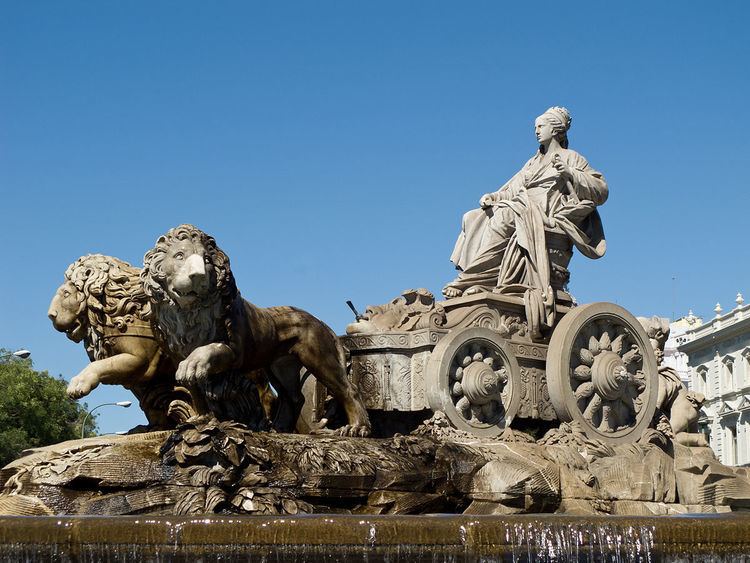 | ||
Hours Open today · Open 24 hoursSaturdayOpen 24 hoursSundayOpen 24 hoursMonday(Benito Juárez's birth)Open 24 hoursHours might differTuesdayOpen 24 hoursWednesdayOpen 24 hoursThursdayOpen 24 hoursFridayOpen 24 hours Similar Parque México, Plaza Rio de Janeiro, Diana the Huntress Fountain, Parque España, Glorieta de los Insurgentes | ||
The fountain of Cibeles in Mexico City is a bronze replica of the fountain located in the Plaza de Cibeles in Madrid that was built during the reign of Charles III by architect Ventura Rodríguez between 1777 and 1792. The Mexican version is located at a traffic circle where Oaxaca, Durango, Medellín and El Oro streets converge in Colonia Roma.
Contents
It was installed in Mexico as a symbol of brotherhood between the Spanish and Mexican communities in 1980 and remodeled in 2011 as part of a remodeling and maintenance program by the government of Mexico City. It is considered to be one of the most emblematic sites in the city, along with the plaza where it is located
History
The Fountain was inaugurated on September 5, 1980, by Mexican President José López Portillo, Madrid mayor, Enrique Tierno Galván and Mexico City mayor Carlos Hank González. Féretro
The fountain is located in a plaza which used to be the Plaza of Miraville “created in the 19th Century at the intersection of the antique carriageway of access to the lands that belonged to the family of the Third Countess of Miravalle” Today they are Durango and Oaxaca streets. Underneath this plaza there was a well that served as the main source of drinking water for the Roma Burough This copy of the Spanish fountain was donated by Spanish immigrants to Mexico.
In 2011, then-Mexico City mayor Marcelo Ebrard announced that the fountain was one of the 67 monuments to receive maintenance and remodelation. The renovation included the “reintegration of missing pieces, restoration of bronze sculptures, rehabilitation of the water system, improvement of green areas and illumination with the objective of reducing electring energy spending 30%”. The re-inauguration of the fountain was on January 21, 2011, by the same mayor, the Spanish ambassador to Mexico Manuel Alabart, and Secretary of Works and Services of the Government of the Federal District, Fernando Aboitiz.
Description and Access
The group of sculptures measures approximately 12.5 meters long, 4.7 meters in width and 5.5 meters tall with a weight of 12 tons. It is located two blocks away from Metro Insurgentes and two blocks away of the Durango Metrobus station in the crossing of four streets: Oaxaca, Durango, Medellin and el Oro.
The fountain is located in the middle of a traffic circle surrounded by stores and restaurants that make up the Plaza Cibeles. Once a week, a flea market is installed and is commonly known as “el tianguis de la Cibeles” or “el bazar de Oro”
Spanish community
The fountain was donated by the community of Spanish residents in Mexico and was “erected as a symbol of brotherhood between both metropolis”, Mexico City and Madrid.
The ambassador of Spain in Mexico, Manuel Alabart, thanked the head of government of the Federal District Marcelo Ebrard for the renovations made in 2011 of what he called an “emblematic space” that makes Madrid and Mexico City closer, as well as for the “warmth and hospitality the city gives to almost 40 thousand spanish that live in the Federal District”. Ebrard also mentioned the importante of the emblematic work of the remodelation that “strengthens the ties of friendship between Spain and Mexico.
Even the trade surrounding the Plaza Cibeles is known for its Madrilenian style and influence. It has also become a tradition for the fountain to be invaded by fanatics of the Spanish soccer team in celebration of its victories.
Symbolism
The fountain consists of the statue of the goddess Cybele, Roman goddess of fertility, who wears a crown and carries a scepter and key, symbols of her power of Earth and the stations and goes in a carriage pulled by lions. The lions represent Hippomenes and Atalanta, one of the huntresses of the goddess Diana.
